Obama’s Middle East Challenge – Part II
Obama’s Middle East Challenge – Part II
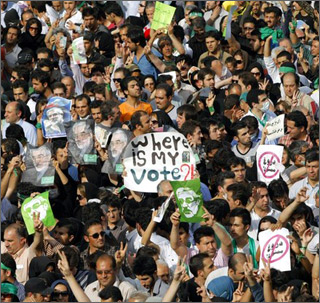
LONDON: For the first time since the founding of the Islamic Republic, following the Shah’s overthrow by massive street demonstrations, the power of the state is being challenged. A broad-based coalition of reformist and pragmatic conservative Islamic elements has risen peacefully against the contested reelection of Mahmoud Ahmadinejad and the hard line clerics, Revolutionary Guard commanders and intelligence officials around him.
The unseemly haste with which a landslide victory was attributed to Ahmadinejad has led to a protest unparalleled since the 1979 anti-Shah revolution. The poll was viewed as a referendum not only on the curtailment of social and cultural freedoms of Iranians, and the mismanagement of the economy, but also Ahmadinejad’s unnecessarily provocative statements on Iran’s relations with the West and Israel, as well as the nuclear issue. So, the outcome of the current crisis will reverberate beyond Iran’s border.
Shaken by the protest, the supreme leader Ayatollah Ali Khamanei asked the 12-member Guardian Council to investigate the challengers’ complaints. The Council is the ultimate authority for validating the poll. Its decision could go down in history as a crucial turning point for the Islamic Republic and the region.
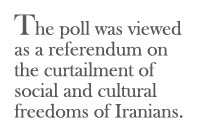
In many ways this election has been different. Traditionally, the Iranian regime loosens its iron grip over dissenters and oppositionists during the presidential election campaign, and rules regarding watching satellite TV are relaxed in a bid to encourage voters to participate in the poll.
The three 90-minute TV debates between the incumbent President Mahmoud Ahmadinejad and each one of his three challengers provided an unprecedented opportunity for the opposition leaders to criticize the government before an estimated audience of 50 million. These no-holds barred debates proved thrilling. This was particularly true of the one between Ahmadinejad and Mousavi, who was Iran’s prime minister during the 1980-88 Iran-Iraq War. At one point Mousavi derided Ahmadinejad’s foreign policy as one founded on “adventurism, illusionism, exhibitionism, extremism and superficiality.”
Also unique to this election, young supporters of Mousavi used text messages as never before to shore up votes for him. Enthusiastic backing by Mohammed Khatami, the elder statesman of the reformist camp, bolstered Mousavi’s standing too, and led to massive pre-election rallies
At 84%, voter participation was the second highest after the record 88% in 1997 when seven out of ten voters backed Khatami as president.
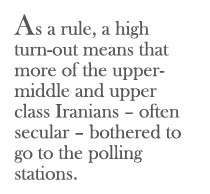
As a rule, a high turn-out means that more of the upper-middle and upper class Iranians – often secular – bothered to go to the polling stations. In general, as a largely alienated group in a theocratic system, they find voting pointless. The second highest voter turn-out in the eleventh presidential poll on June 12 indicated a surge of support for reformist Mousavi against Ahmadinejad.
It was not just the professional pollsters who predicted victory for Mousavi – albeit based on samples limited to ten largest cities – but also a private polling of 5,000 Iranians conducted nationwide for Khamanei. Its result, leaked to the Sunday Times of London, showed 58% backing Mousavi.
Little wonder that the official result of 62.6% for the incumbent and nearly 34% for Mousavi – collated and announced within two hours of the polling ending at midnight without the presence of the candidates’ monitors – came as a shock to most people in Iran and abroad.
Since then, among the varying statistics that have appeared on the opposition websites, one, attributed to an “informed source” in the Interior Ministry, gives Mousavi 57.2% of the vote, Ahmadinejad 28%, and the remaining two contestants together nearly 15%, versus the 3% accorded to them by the official count.
At home, the silent marches of hundreds of thousands of supporters of Mousavi in Tehran and other cities on June 15 and 16 showed the widespread distrust of the poll results.
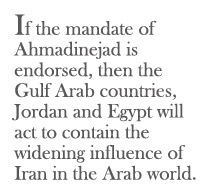
Responding to the protest by all three opposition candidates, Khamanei instructed the Guardian Council on June 15 to “consider precisely” their complaints. Describing the announced result as “provisional”, the council’s spokesman said that it would rule within the next 10 days. While conceding a possible change in the final tally after a recount, he ruled out a wholesale re-run of the election. Therefore the street protests are continuing with a plan to pray in mosques on Friday for those martyred in the official clamp-down.
And these protests have been massive; in some cases bi-partisan. Reformist forces joined the pragmatic conservative camp in voicing their anger. Of note, the conservative camp is led by Ali Akbar Hashemi Rafsanjani, a former president, who was beaten by Ahmadinejad in the 2005 poll. During the recent election campaign, Ahmadinejad attacked Rafsanjani as corrupt and derided his three challengers as Rafsanjani’s puppets.
Rafsanjani is chairman of the Assembly of Experts, a directly elected constitutional body, composed exclusively of clerics, with an eight-year tenure. Based in the holy city of Qom, it elects the Supreme Leader for eight years, and monitors his performance. Normally it meets twice a year, and considers, inter alia, its select committee’s report on the Supreme Leader’s performance. As the Assembly’s chairman, however, Rafsanjani is entitled to call an emergency session.
During the last weekend Rafsanjani reportedly traveled to Qom to sound out the Assembly’s leading members on debating the contested election. The overall judgment was that so far it has been an administrative – not constitutional – affair.
But that could change if the Assembly’s select committee concludes that Khamanei failed to act as the neutral overseer of the election as required of him constitutionally. If the Assembly then summons him to explain his behavior in person, that could shake the very foundation of the Islamic Republic. A destabilized Iran will set back Obama’s efforts to mend fences with the Muslim world. For now the turmoil in Iran has left the regional capitals confused. Though Washington has refrained from passing judgment on the poll itself, Iran’s foreign ministry summoned the Swiss ambassador, who represents American interests, to protest “interventionist” statements by the United States.
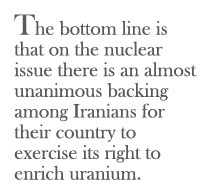
If the renewed mandate of Ahmadinejad is endorsed by the Guardian Council, then the Gulf Arab countries, Jordan and Egypt will act to contain the widening influence of Iran in the Arab world – as manifested in its backing for Hamas in Palestine and Hezbollah in Lebanon. They will get even closer to the US, and the Saudis will try hard to break up the Syrian-Iranian alliance. Obama will find himself having to deal with a re-elected Ahmadinejad, more obdurate on the nuclear question than ever before.
However, it is worth noting that Iran’s major defense and foreign policies are decided by the 11-member Supreme National Security Council chaired by the President. Of these, only two are the personal representatives of the Supreme Leader.
The bottom line is that on the nuclear issue there is an almost unanimous backing among Iranians for their country to exercise its right to enrich uranium, which is allowed under the nuclear Non-Proliferation Treaty (NPT) that Iran has signed.
So even if Mousavi did succeed Ahmadinejad, there would be no change in Tehran’s stance on this issue. What would be different would be the style – more measured and nuanced, with diplomatic niceties, shorn of the anti-Israeli, anti-West bluster characteristic of Ahmadinejad, which seems to go down well with the rural population of Iran where he undoubtedly trumped Mousavi at the last poll.
Dilip Hiro’s latest book is Inside Central Asia: A Political and Cultural History of Uzbekistan, Turkmenistan, Kazakhstan, Kyrgyzstan, Tajikistan, Turkey and Iran, published by Overlook Press, New York.